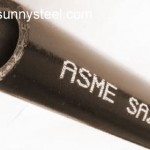American Society for Testing and Materials

American Society for Testing and Materials (ASTM), is an international standards organization that develops and publishes voluntary consensus technical standards for a wide range of materials, products, systems, and services.
As steel rolled out of mills throughout the Pennsylvania and Ohio valleys, buildings, railroads, automobiles and roadways depended on the quality of the steel products. Today, the ASTM sets standards across a wide range of markets; the organization plays a leadership role with the World Trade Organization in developing international standards which oversee industries across the globe with consensus, impartiality, and transparency. The American Society for Testing and Materials (ASTM) was established in the 1800s to work with the steel mills in Pennsylvania to regulate the production of steel used in the nation’s industrial revolution.
Elasticity, Yield, Hardness, Shear
The ASTM standards categorize steel’s properties, and measure its performance across the four characteristics: the “Modulus of Elasticity” refers to how far a piece of steel is can be deformed by applied stress and still return to its original shape, “Tensile Hardness” refers to the amount of stress that can be applied to the steel before it deforms, “Minimum Yield Stress” refers to the point at which steel will permanently deform and “Shear” applies to the amount of force the steel experiences at the point at which a piece of steel to undergo a clean break across its axis, perpendicular to the force. Each of these characteristics affects and defines steels’ strength and defines parameters engineers use to select kinds of steel for specific applications.
ASTM A106 Covers seamless carbon steel nominal wall pipe for high-temperature service, suitable for bending flanging and similar forming operations.
When rating steel products, the ASTM measures and rates all types of steel manufactured and supplied to industry. Six classes of carbon steel are monitored, as carbon is one of the most commonly used additives in steel manufacturing. The amount of carbon in a steel product affects the strength of the steel; steel is commonly discussed as low-carbon, medium-carbon and high-carbon, but the ASTM breaks down those categories even further, since steel with a higher carbon content can be tempered to greater strengths than low-carbon steel.
Alloy Steel
ASTM A333 Pipe shall be made by the seamless or welding process with the addition of no filler metal in the welding operation.
Steel is also classified as alloy steel when metals other than carbon are added to the molten iron to improve the performance characteristics of the metal. The ASTM identifies seven classes of alloy steel forgings; the details of classifications include the percent and type of alloy content, heat treating procedures which affect each type of alloy and the mechanical properties of each. These properties are measured, classified and tracked in detail for each of the steel alloys.
Forged, Cast and Rolled
Once iron is in a molten state, it’s processed hundreds of ways as it’s converted into usable steel products. Each process affects the strength of the product, and therefore affects its usefulness and reliability for specific applications. Steel is cast or poured as molten iron into molds like hot wax, and allowed to cool into pipes, fittings, engine blocks, etc. Structural and sheet steels are rolled into many shapes, beams, bars and coils and shipped to manufacturing plants around the country. The ASTM sets guidelines for all these products so that purchasers are assured they receive the steel specifically designed for their application.
Heat-treated and Non-treated
Steel can either be heat treated or not, and the ASTM guidelines cover the details of the treatment process and set a hardness scale. Heat-treated steel is more rigid and stronger across the four categories listed above, and also removes the internal stresses and weaknesses which are part of the steel as a result of the shaping processing. Heat-treating is characterized by over 50 different terms which describe the internal changes, how the steel acts and the steel’s appearance after the treatments.











Hi, this is a comment.
To delete a comment, just log in and view the post's comments. There you will have the option to edit or delete them.